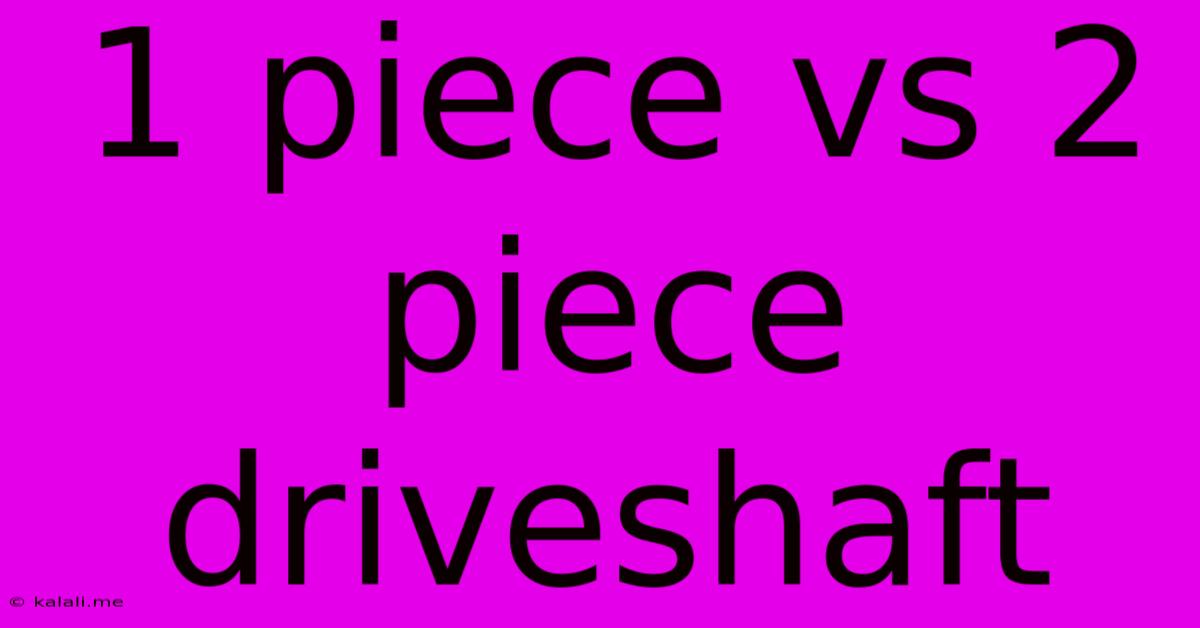1 Piece Vs 2 Piece Driveshaft
Kalali
Jun 03, 2025 · 3 min read

Table of Contents
1-Piece vs. 2-Piece Driveshaft: Which is Right for Your Vehicle?
Choosing the right driveshaft is crucial for optimal vehicle performance and longevity. This article delves into the key differences between one-piece and two-piece driveshafts, helping you understand which option best suits your needs. Understanding the pros and cons of each type will empower you to make an informed decision, whether you're building a custom vehicle or troubleshooting a drivetrain issue.
What is a Driveshaft? A driveshaft, also known as a propeller shaft, transmits power from the transmission to the differential, enabling your vehicle to move. The design, however, can significantly impact performance and durability.
One-Piece Driveshafts: Simplicity and Strength
One-piece driveshafts are, as the name suggests, a single, continuous shaft. This design offers several advantages:
- Increased Strength and Durability: A single, unbroken shaft inherently possesses greater torsional strength and rigidity compared to a two-piece design. This makes them ideal for high-torque applications and off-road vehicles where significant stress is placed on the drivetrain.
- Reduced Vibration: The absence of a center support bearing minimizes potential vibration points, leading to a smoother driving experience. This contributes to enhanced comfort and reduced wear and tear on other drivetrain components.
- Simpler Design and Installation: The simpler design translates to easier installation and less potential for misalignment issues. Fewer components mean fewer potential points of failure.
However, one-piece driveshafts also have limitations:
- Length Restrictions: Due to their single-piece construction, they are limited in length. This makes them unsuitable for vehicles with longer wheelbases or those requiring significant driveshaft articulation.
- Difficult Installation in Certain Vehicles: Their length can create difficulties during installation, particularly in vehicles with limited access to the drivetrain.
- Cost: While not always the case, a longer single piece shaft can potentially be more expensive to manufacture and replace.
Two-Piece Driveshafts: Flexibility and Adaptability
Two-piece driveshafts consist of two separate shafts connected by a center support bearing. This design offers flexibility and adaptability that one-piece shafts lack:
- Increased Flexibility for Longer Wheelbases: The two-piece design allows for longer overall driveshaft lengths, accommodating vehicles with extended wheelbases. This is particularly useful in trucks, SUVs, and custom builds.
- Improved Articulation: The center support bearing allows for greater articulation, making them suitable for vehicles requiring significant suspension travel, such as off-road vehicles.
- Easier Installation and Replacement: The shorter shafts are generally easier to install and replace, reducing labor costs and downtime.
Despite their advantages, two-piece driveshafts have drawbacks:
- Potential for Increased Vibration: The center support bearing introduces an additional point of potential vibration. Proper installation and bearing maintenance are essential to minimize this issue.
- Additional Maintenance: The center support bearing requires regular inspection and lubrication to prevent premature wear and failure. This increases overall maintenance requirements.
- Reduced Strength Compared to One-Piece: While robust, the two-piece design is inherently less strong than a single, continuous shaft, making them less suitable for extremely high-torque applications.
Choosing the Right Driveshaft: Factors to Consider
The optimal choice depends heavily on your vehicle's specific requirements:
- Vehicle Type: High-performance vehicles, off-road vehicles, and those with substantial suspension travel may benefit from a one-piece driveshaft for its strength and reduced vibration. Vehicles with longer wheelbases often require the flexibility of a two-piece design.
- Torque Output: High-torque engines necessitate a robust driveshaft capable of handling the increased stress. One-piece shafts generally excel in this area.
- Budget: The cost of manufacturing and replacing a driveshaft is a key consideration.
- Maintenance: Two-piece driveshafts require additional maintenance for the center support bearing.
By carefully considering these factors, you can select the driveshaft that best balances performance, durability, and practicality for your specific application. Remember to consult with a professional mechanic for advice tailored to your vehicle.
Latest Posts
Latest Posts
-
Is 49 A Prime Or Composite Number
Jul 16, 2025
-
Is 75 The Same As 3 4
Jul 16, 2025
-
How Old Am I If I Was Born In 1968
Jul 16, 2025
-
What Do You Call A Baby Donkey
Jul 16, 2025
-
What Is The Average Height Of A 12 Year Old
Jul 16, 2025
Related Post
Thank you for visiting our website which covers about 1 Piece Vs 2 Piece Driveshaft . We hope the information provided has been useful to you. Feel free to contact us if you have any questions or need further assistance. See you next time and don't miss to bookmark.